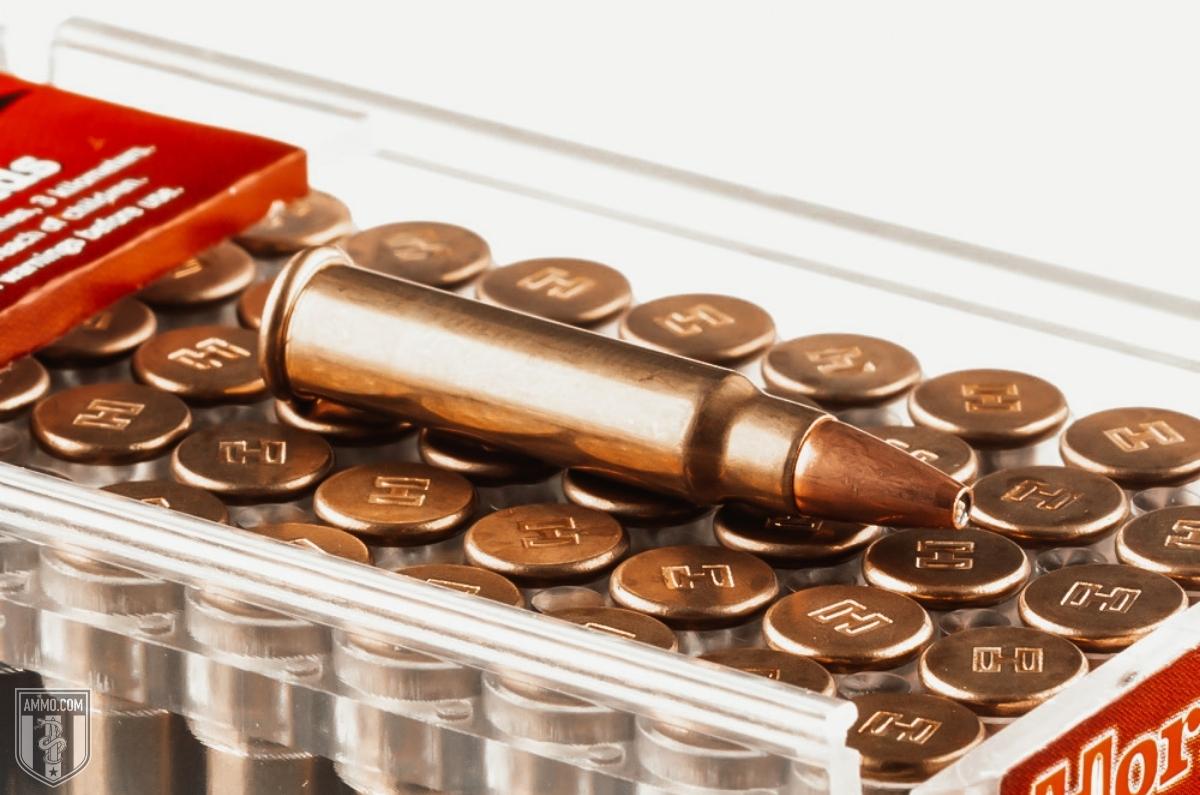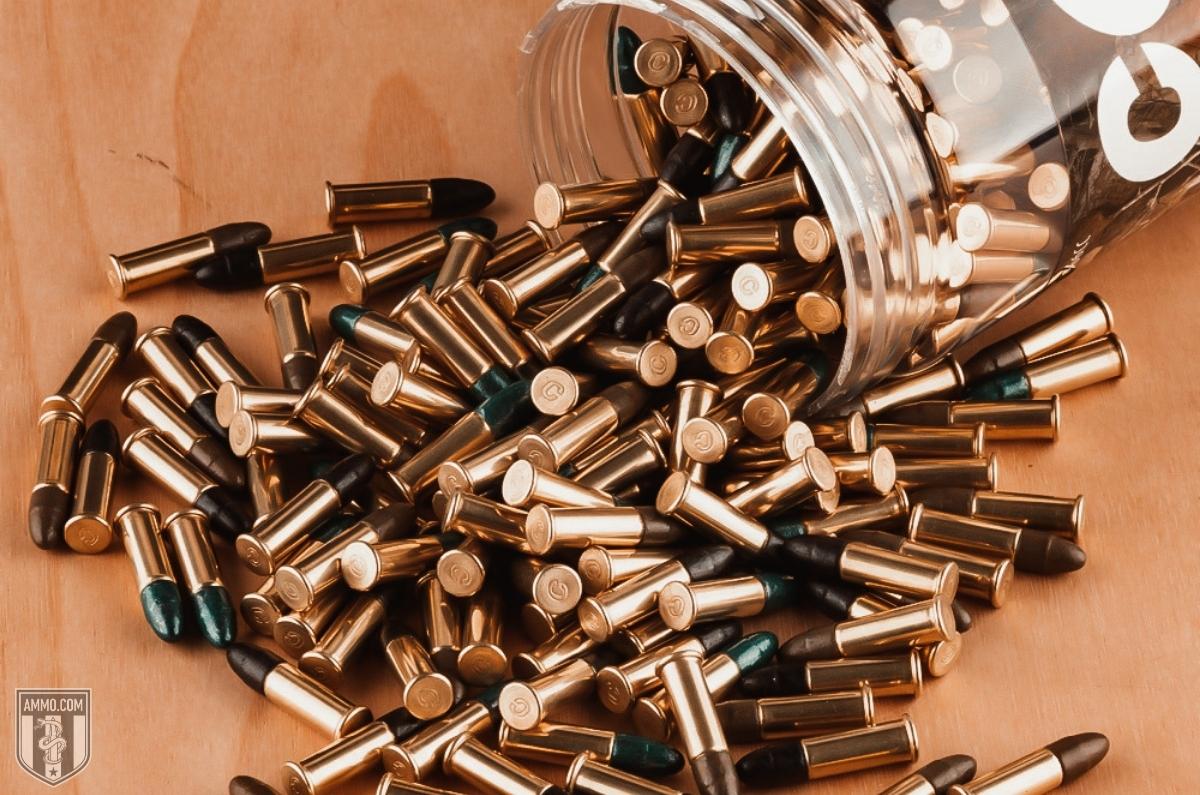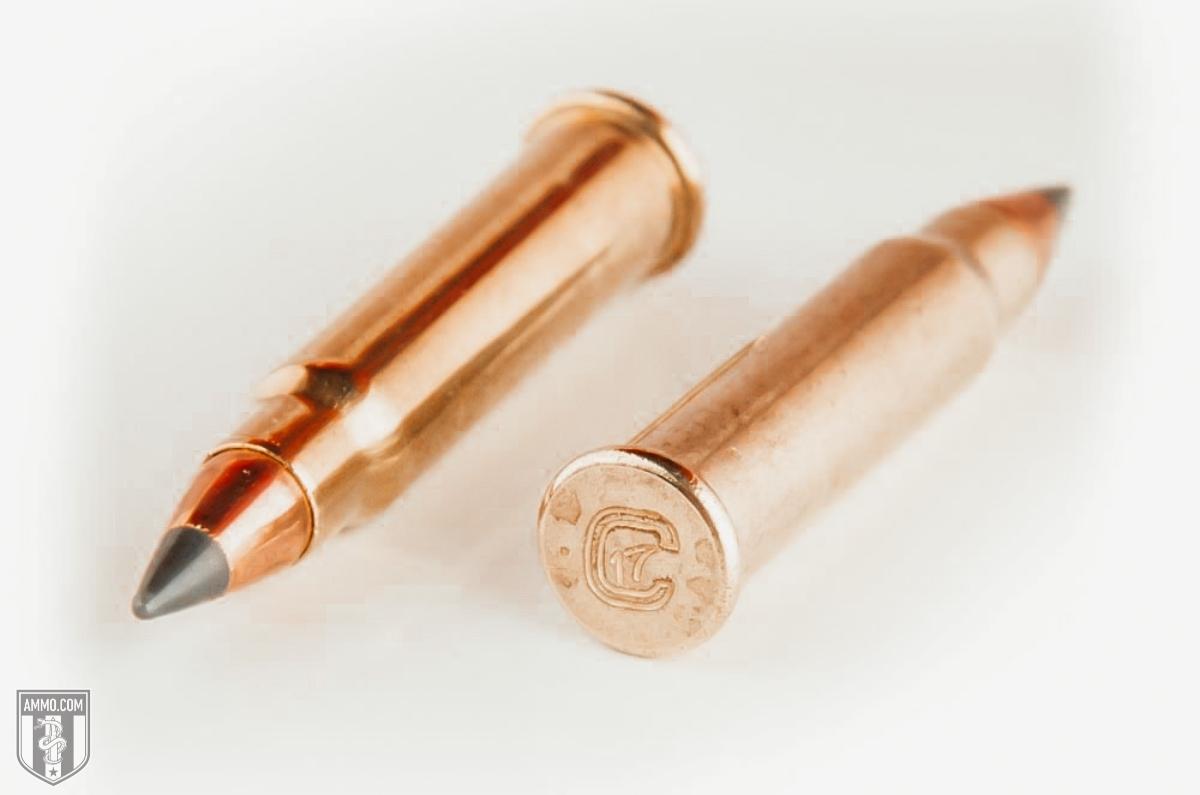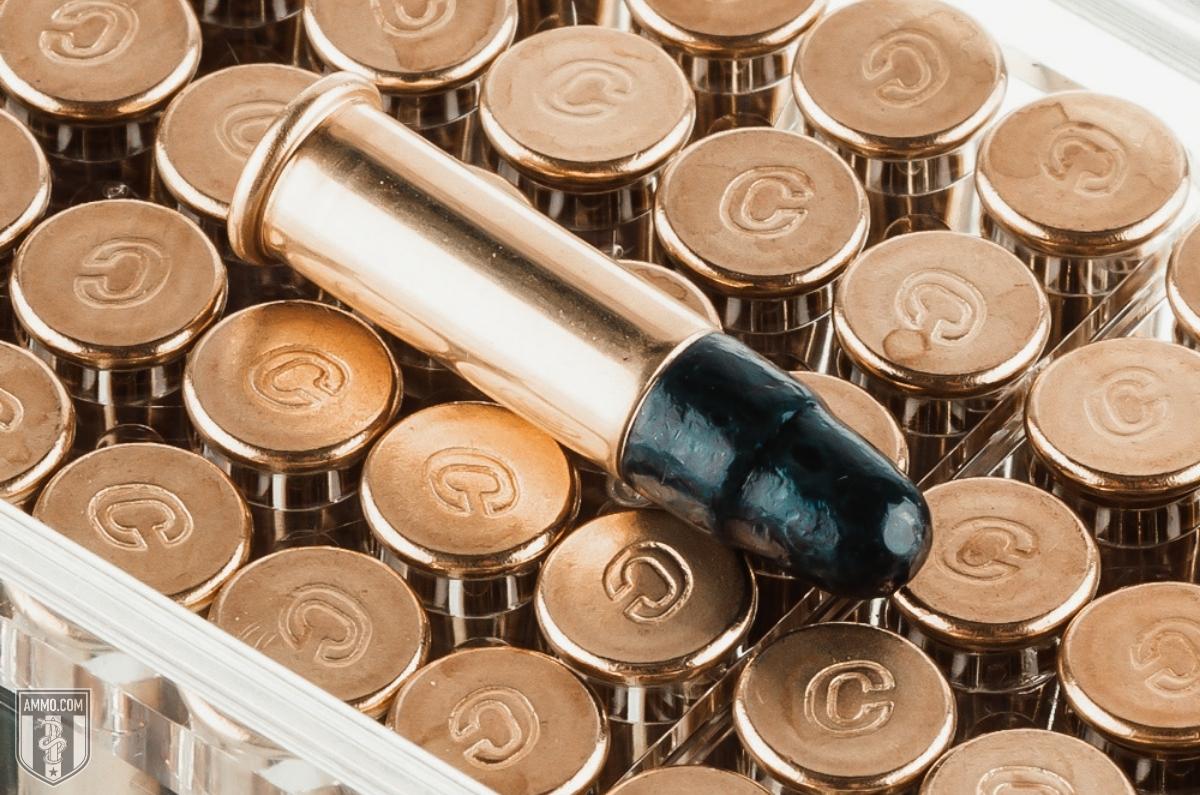17 HMR vs 22: Not Your Grandfather’s Rimfire
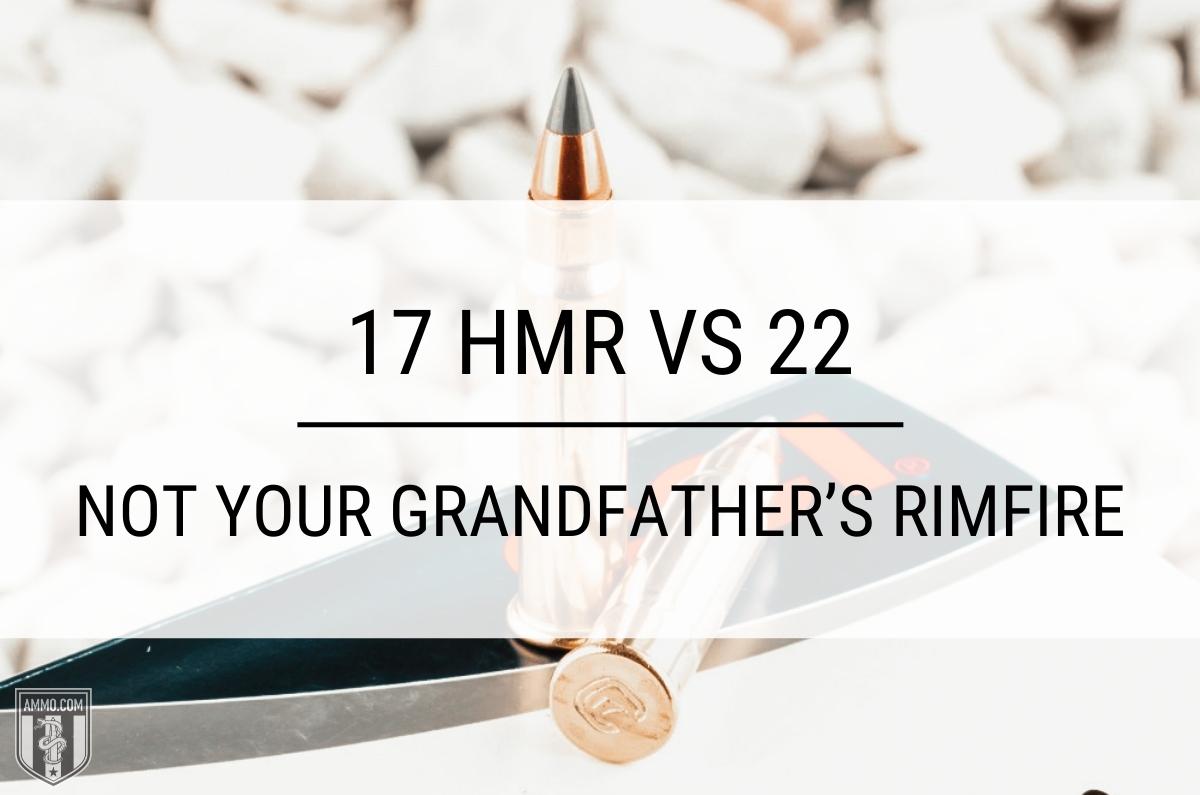 From the late 1950s to the early 2000s, two of the most popular rimfire cartridges on the planet were the 22 Long Rifle and the 22 Winchester Magnum Rimfire, otherwise known as the 22 WMR or 22 Mag. Generations of shooters (myself included) were taught how to shoot using a 22 LR bolt-action rifle before hunting varmints like coyotes and groundhogs with a 22 WMR.
From the late 1950s to the early 2000s, two of the most popular rimfire cartridges on the planet were the 22 Long Rifle and the 22 Winchester Magnum Rimfire, otherwise known as the 22 WMR or 22 Mag. Generations of shooters (myself included) were taught how to shoot using a 22 LR bolt-action rifle before hunting varmints like coyotes and groundhogs with a 22 WMR.
But then in 2002, Hornady changed the rimfire landscape when they introduced the 17 Hornady Magnum Rimfire (17 HMR). Varmint hunters clambered to acquire the new rimfire cartridge that sported muzzle velocities nearly double that of 22 LR for standard velocity loads.
But does the flatter 17HMR trajectory and longer effective range mean you should sell your grandfather’s stalwart 22LR rifle?
In this article, we will examine the differences between 17 HMR and 22LR to help you select the best rimfire cartridge for your needs.
What is the Difference Between 17 HMR and 22LR?
The difference between 17HMR vs 22LR is that the 17 HMR fires a 0.172” diameter bullet while the 22 LR fires a 0.2255” diameter bullet. The 17 HMR case is also larger, meaning it can hold more powder and therefore achieve higher muzzle velocity than a 22 LR.
Cartridge Specs
When evaluating rimfire cartridges, it’s a good idea to analyze the cartridge specs to gain more knowledge of each.
The first, and most obvious, difference between 22LR vs 17HMR is the diameter bullet each rimfire cartridge fires. The 22 Long Rifle fires the larger 0.2255” diameter bullet compared to 0.172” for the 17 HMR.
This difference correlates with the bullet weight each cartridge fires. The 17 HMR typically fires lighter 17 grain projectiles, although 20 grain options are available, while the 22LR heavier bullets between 20 and 60 grains, with a 40-grain bullet being the most common.
The second major difference between 17 HMR compared to 22 is their case length. The 22LR measures a diminutive 0.613” long, compared to 1.058” for the 17 HMR. This means that the 17 HMR will have a larger case capacity, which in turn will increase muzzle velocity.

The final noticeable difference 17 HMR vs 22 is their listed max pressures. The 17 HMR can handle higher pressures at 26,000 psi compared to 24,000 psi for .22LR.
Recoil
One of the greatest qualities of rimfire ammo is their low recoil impulse, making them ideal for training new shooters. This low felt recoil is a result of the design of the rimfire cartridge itself. A rimfire cartridge has the priming compound located in the rim of the cartridge that is ignited when the firing pin pinches the case rim. This means that the case rim must be thin enough to be pinched to ensure ignition.
This, in turn, requires that rimfire ammo have lower pressure than centerfire cartridges so as not to breach the rim of the cartridge. Take for example, the 223 Remington, which is another common varmint round. The 223 Rem has a max pressure of 55,000 psi whereas the 22 LR and 17 HMR both have a max pressure close to 24,000 and 26,000 psi, respectively.
Therefore, rimfire ammo will always have a lower recoil impulse than centerfire ammo.
To learn more about the differences, read our article on rimfire vs centerfire.
When it comes to shooting a rimfire cartridge, typically recoil is nothing more of an afterthought as it is so low. This virtually non-existent recoil impulse allows new shooters to focus on the fundamentals of marksmanship without developing a recoil-anticipation flinch.
Despite the differences in case capacity, neither rimfire cartridge has oppressive recoil. The 22LR measures around 0.2 ft-lbs of felt recoil compared to 0.3 ft-lbs for 17 HMR.
The 22 LR technically has less felt recoil than the 17 HMR, but the difference is so slight that most shooters will not be able to tell the difference.
Muzzle Velocity and Kinetic Energy
Muzzle velocity, measured in feet per second (fps) is the speed at which the bullet leaves the barrel of the firearm. Generally, a longer barrel length will generate a higher muzzle velocity because it allows for a more complete powder burn.
Muzzle energy is measured in foot-pounds (ft-lbs) and is a measurement of how much force a bullet delivers to its target at a given range.
Although there is very little difference in terms of recoil, the 17 HMR clearly dominates in terms of muzzle velocity and energy.
The 17 HMR was designed to be nothing short of a speed demon, and its light weight 17 grain bullets comes screaming out of the muzzle at 2,550 fps compared to 1,070 for CCI standard velocity 22 LR.
In terms of muzzle energy, the 17 HMR continues its domination with 245 foot-pounds of stopping power compared to 100 for 22LR.
The 17 HMR clearly dominates in both velocity and energy with its lighter bullets.
Trajectory
Trajectory is how we quantify a bullet’s flight path as it travels downrange measured in inches of bullet drop.
Obviously, a flatter shooting cartridge is preferred for long range shooting, as a shooter will require fewer adjustments to their optics to compensate for bullet drop. Having a flatter trajectory also means that a cartridge will be more forgiving of ranging mistakes.
The 17 HMR was specifically designed as a high velocity long range target shooting and varmint hunting rimfire cartridge, as such it has a flatter trajectory than 22 LR.
The high muzzle velocity of the 17 HMR is the main reason for its flat trajectory, as it can remain supersonic out to nearly 250 yards. Compare that to the fastest 22 LR loads, like the CCI Stinger traveling at 1,640 fps, that can only remain supersonic to about 100 yards.
At 150 yards, the 17 HMR has experienced -3” of bullet drop compared to -11” of bullet drop for the 22 LR.
The 17 HMR is the clear winner in terms of trajectory.
Ballistic Coefficient
Ballistic coefficient (BC) is a measure of how well a bullet resists wind drift and air resistance. Put another way, it’s a numeric representation of how aerodynamic a bullet is. A high BC is preferred as this means the bullet will buck the wind easier.
Generally, heavy bullets will have a higher ballistic coefficient as it takes more force to disrupt the flight of a heavier bullet than a lighter one. Ballistic coefficient varies from bullet to bullet based on design, weight, and other factors that are beyond the scope of this article.
This is one category where the heavier bullet weight of the 22LR gives it a slight edge over the 17 HMR. On average, BC for 22 LR measures around 0.13 compared to 0.11 for 17 HMR.
However, that does not mean that the 22 LR in more effective at resisting wind drift. On the contrary, the low muzzle velocity of the 22 LR makes it more susceptible to being tossed around in a breeze than the 17 HMR.
Assuming a 10-mph cross wind, at 150 yards the 22 LR will have drifted an average of 12” compared to 8” for 17 HMR. The high velocity of the 17 HMR means that its bullet will reach the target faster, meaning the wind will have less time to affect its flight path.
Accuracy
When it comes to accuracy for any rifle cartridge, ammo consistency is one of the key factors to consider. Normally this is a non-issue for centerfire cartridges as they can be reloaded, but for rimfire you are at the mercy of factory loads since they cannot be reloaded.
As the 22 LR is one of the most mass-produced rounds on the planet, accuracy can be variable between lots and manufacturers. With match grade ammo and a well-tuned match grade bolt-action rifle, 22 LR can achieve 1 MOA level accuracy. However, for most off the shelf bulk ammo, you should expect no better than 1.5 MOA accuracy. On the other hand, 17 HMR ammo seems to consistently achieve 1 MOA results or better with less expensive, off-the-rack rifles.
There are differing opinions as to why 17 HMR ammo seems to be more accurate than 22 LR. Some theorize ammunition companies initially wanted to offer extremely high quality 17 HMR ammo to boost sales, and they simply never stopped this process.
Regardless of the reason, the 17 HMR is consistently rated as one of the most accurate and consistent rimfire cartridges on the market, making it a great choice for target shooting.
Hunting
If there’s one thing that rimfire ammo excels at, it’s pest control and varmint hunting. Regardless of what critters plague your property, there’s a rimfire cartridge ready to take care of it for you. From squirrels, raccoons, groundhogs, prairie dogs, and coyotes, rimfire ammo gives you the versatility to take care of them all.
Based on the superior ballistic performance and effective range, some shooters might think that the 17 HMR is the perfect pest control cartridge. The 17 HMR is an amazing rimfire cartridge on paper, however it does have some drawbacks that don’t necessarily show up on ballistics tables.
For small game hunting, the 22 Long Rifle is typically all that you need. For short range shots (50 yards or less) like those taken when sniping squirrels, raccoons, or even groundhogs, a hollow point 40-grain bullet is hard to beat. It has the penetration and expansion you want for a clean kill, and it also won’t destroy all the meat.
The high velocity and lighter bullets the 17 HMR fires will generally fragment violently on impact. This is great if you want to cause the most damage possible, but bad if you are looking to use the meat or hide of the varmint. Listen, I like exploding critters just as much as the next varmint hunter, but if you are wanting to preserve anything, then the 22 LR is the better option for small game hunting.
When we step it up a little to larger game or longer distances, the 17 HMR starts to shine. For taking on prairie dogs, groundhogs at distance, or woodchucks, the 200+ yard effective range and flat trajectory of the 17 HMR really gives hunters a longer reach than they can every hope to get with a 22 LR.
There is some scholarly debate among varmint hunters about the effectiveness of either cartridge on coyotes. It’s true that you can take a coyote with either cartridge, provided that your shot placement is good. However, as an ethical hunter, using either the 22LR or 17HMR is probably not the best choice for coyotes. For these larger varmints, I’d rather utilize something more powerful like a 22 WMR, 17 WSM, or a centerfire rifle cartridge like a 223 Remington or 22-250. Just because the 22 LR and 17 HMR can be used for these canines, it doesn’t mean that either is the best choice.
Ammo and Rifle Cost/Availability
When it comes to ammo price and availability, the 22 LR cannot be beat.
As the .22LR has been in service for just short of 140 years, it has survived the test of time and remains the most popular rimfire cartridge in the world. As such, virtually every ammo manufacturer like Remington, CCI, Federal, Winchester has a rich supply and variety of 22 LR rimfire ammo available for purchase.
For more options, check out our Remington 22LR ammo, Wolf Ammo 22 LR or Fiocchi 22LR ammo page.
In comparison, the 17 HMR has only been on the market for 20 years…a mere infant compared to the tried-and-true 22 LR. Therefore, there are fewer manufacturers who produce 17 HMR ammo. However, Hornady, Browning, Remington, Winchester, and Federal all have loads for 17 HMR.
On average, your run of the mill 40-grain fmj 22 LR ammo will set you back about $0.15/round, typically sold in bricks of 300 rounds or more. In contrast, 17 HMR ammo will typically set you back around $0.38/round, over double that of the 22 LR.
When it comes to ammo variety, the 22 LR has nearly a 6:1 advantage over 17 HMR. The 22LR can be found in full metal jacket (fmj), bare lead, coated lead, hollow point, solid point, copper plated, with varying velocities (both supersonic and subsonic). The most common 17 HMR bullets are the 17 grain V-MAX from Hornady, as this was the original design submitted to SAAMI. However, some manufacturers are now offering hollow point and fmj loads to give some versatility in the 178 HMR.
As for rifles, the popularity of the 17 HMR cannot even come close to that of the 22 LR. However, virtually every firearm manufacture who makes a rimfire rifle has one chambered in 22 LR and 17 HMR.
From bolt-action to semi-auto to lever-action and even handgun options, the 22 LR has it all. Pick your favorite manufacturer, such as Browning, Savage, Ruger, Walther, Marlin, or Winchester and you’ll find a plethora of 22 LR firearm option.
Due to its higher pressure and velocity, most 17 HMR rifles are bolt-action. However, if you’re in the market for a semi-automatic 17 HMR rifle, the Savage Model A17 is your best option. And if you’re wanting a handgun chambered in 17 HMR, you’ll mostly be relegated to revolvers whereas the 22 LR has multiple semi-auto choices on the market.
In terms of price point, there isn’t a huge difference in factory new 22LR and 17 HMR rifles. However, there is a greater number of 22 LR rifle and handgun options available as the cartridge has been available for longer.
Ballistics: .17 HMR vs .22
Our team here at Ammo.com has spent countless hours scouring the Internet to bring you extremely comprehensive ballistics tables for both calibers. Below are tables that compare bullet weight to muzzle velocity, kinetic energy, and trajectory for both 22LR vs 17HMR.
17 HMR Ballistics: Chart of Average 17 HMR Ballistics
Note: This information comes from the manufacturer and is for informational purposes only. The actual ballistics obtained with your firearm can vary considerably from the advertised ballistics. Also, ballistics can vary from lot to lot with the same brand and type load.
| 17 HMR Bullet WEIGHT | Muzzle VELOCITY (fps) 22-1/2" Bbl. | Muzzle ENERGY (ft. lbs.) 22-1/2" Bbl. | Mid-Range TRAJECTORY (in.) | Muzzle Velocity | ||
|---|---|---|---|---|---|---|
| Muzzle | 100 yds. | Muzzle | 100 yds. | 100 yds. | 6" Bbl. | |
| 15.5 Grain Lead Free | 2550 | 1901 | n/a | n/a | 0.9 | n/a |
| 16 Grain TNT Green | 2500 | 1642 | 222 | 96 | n/a | n/a |
| 17 Grain | 2550 | 1902 | 245 | 136 | n/a | n/a |
| 20 Grain | 2375 | 1776 | 250 | 140 | n/a | n/a |
22 Long Rifle (LR) Ballistics: Chart of Average 22 Long Rifle (LR) Ballistics
Note: This information comes from the manufacturer and is for informational purposes only. The actual ballistics obtained with your firearm can vary considerably from the advertised ballistics. Also, ballistics can vary from lot to lot with the same brand and type load.
| 22 Long Rifle (LR) Bullet WEIGHT | Muzzle VELOCITY (fps) 22-1/2" Bbl. | Muzzle ENERGY (ft. lbs.) 22-1/2" Bbl. | Mid-Range TRAJECTORY (in.) | Muzzle Velocity | ||
|---|---|---|---|---|---|---|
| Muzzle | 100 yds. | Muzzle | 100 yds. | 100 yds. | 6" Bbl. | |
| 30 Grain Lead Free | 1650 | n/a | 181 | n/a | n/a | n/a |
| 30 Grain Hyper Vel | 1750 | 1191 | 204 | 93 | n/a | n/a |
| 31 Grain Shot #12 | 950 | n/a | n/a | n/a | n/a | n/a |
| 32 Grain Hyper HP | 1500 | 1075 | 165 | 85 | 2.8 | n/a |
| 32 Grain Expediter | 1640 | n/a | 191 | n/a | n/a | n/a |
| 32 Grain Stinger HP | 1640 | 1132 | 191 | 91 | 2.6 | 1395 |
| 37 Grain Segmented HP | 1435 | 1080 | 169 | 96 | 2.9 | n/a |
| 38 Grain Sub Sonic HP | 1050 | 901 | 93 | 69 | 4.7 | n/a |
| 40 Grain CCI Quiet | 710 | 640 | 45 | 36 | n/a | n/a |
| 40 Grain Segmented HP | 1050 | 897 | 98 | 72 | n/a | n/a |
| 40 Grain Pistol Match | 1070 | 890 | 100 | 70 | 4.6 | 940 |
| 40 Grain Standard Velocity | 1070 | 890 | 100 | 70 | 4.6 | 940 |
| 40 Grain AutoMatch | 1200 | 990 | 130 | 85 | n/a | n/a |
| 40 Grain Silhouette | 1220 | 1003 | 139 | 94 | 3.6 | 1025 |
| 40 Grain HV | 1255 | 1016 | 140 | 92 | 3.6 | 1060 |
| 40 Grain HV HP | 1280 | 1001 | 146 | 89 | 3.5 | 1085 |
A Brief History of 17 HMR
The .17 Hornady Magnum Rimfire was developed as a joint venture between Hornady, Marlin, and Ruger and was released in 2002. Hornady developed the 17 HMR by taking the 22 WMR (Winchester Magnum Rimfire) case and necking it down to accept a .172” diameter bullet. Initial factory loads from Hornady sported a 17 grain Spitzer V-MAX bullet fired at 2,650 fps.
The 17 HMR was nothing short of an overnight success as hunters loved the high velocity and flat trajectory that the new round offered. Shooters adored the round so much that ammo sales for the new cartridge quickly outstripped production capacity. Thankfully, within 2 years of its release, Remington, CCI, and Federal all began offering their own lines of 17 HMR ammo to help keep up with demand.
Although the 17 grain bullets are the most common, alternative loadings with 15.5 grain and 20 grain bullets are also available.
The 17 HMR is typically chambered in lever-action and bolt-action rifles as there were safety concerns about using the round in early semi-auto rifles, many of which were recalled. However, Savage Arms stepped up to the plate and released the Model A17 in 2015 to give 17 HMR fans a semi-automatic rifle that was completely safe to use.
Although the 17 HMR lacks the stopping power offered by the 22 WMR for larger pests, the Hornady round offers hunters approximately a 50% increase in effective range on small varmints like prairie dogs and groundhogs.
Perfect for target shooting, plinking, and pest control, the 17 HMR offers shooters a low recoil and highly accurate rimfire round that will be popping gophers and groundhogs for years to come.
If you’d like to learn more about how the 17 HMR compares to other calibers, check out 17 HMR vs 22 WMR.
A Brief History of 22 LR
The 22 Long Rifle (LR) is, by units produced, the most common ammunition time produced on the planet. Its low recoil impulse and low cost per round make it ideal for training, plinking, varmint hunting, and target shooting.
The Stevens Arms Company is credited as the original developer of the 22 LR, development began in 1887 and the 22 LR was released in 1884. The 22 LR was a combination of using the case of the 22 Long while combining it with additional powder and the 40-grain bullet of the 22 Extra Long. What Stevens Arms created became to be known as the 22 Long Rifle.
The first ammo manufacturer to commercially produce 22 LR was the Union Metallic Cartridge Company of Bridgeport, Connecticut.
Popularity of the new 22 LR cartridge quickly spread, effectively rendering the 22 Extra Long obsolete. With over 138 years on the market, the 22 LR has become the most popular metallic cartridge on the planet and has been chambered in virtually every firearm imaginable.
A wide variety of bullet weights are available from 20-60 grains, with muzzle velocities varying between 575 to 1,700 fps depending on load and intended application. Subsonic loads are available for use with a suppressor while high velocity loads are excellent for longer range varmint hunting.
Bullet varieties include bare lead, copper plated, full metal jacket (fmj), hollow point, and even No. 12 snake shotshells are available.
With its incredible versatility, low cost per round, and insane popularity, it’s unlikely that the 22 LR will be usurped as The King of the Rimfires anytime soon!
Final Shots: 17 HMR vs 22
The 17 HMR and 22 LR are two extremely potent rimfire cartridges that are effective for target shooting, plinking, and pest control.
Choosing the right cartridge for your needs depends primarily on the type of varmint you plan to hunt and the expected range of engagement.
For small game hunting within 75 yards, the 22 LR is clearly the ideal choice due to its affordability, low recoil, and lower velocity. Although low velocity might sound counterintuitive, the 22 LR has more than enough muzzle energy within these ranges to ethically harvest game without destroying excessive amounts of meat.
However, if you feel the need for speed and want to engage critters out to 250 yards, the 17 Hornady Magnum Rimfire stands ready to meet all your varmint hunting needs. Exceeding muzzle velocities of 2,500 fps, the 17 HMR is an incredibly flat shooting cartridge that is ideal for pest control and long range target shooting. The 17 HMR also has the muzzle energy to take on larger varmints up to coyote-sized game animals.
The cost difference between 17 HMR vs 22 LR cannot be understated either. As the 22LR is one of the most inexpensive rimfire cartridges on the market, you can easily shoot two times as many rounds of 22LR vs 17 HMR for the same price. This adds a level of fun and enjoyment to shooting that cannot be ignored, because there’s nothing like going out to the range and punching some holes in paper or tin cans and not having to worry about the cost.
However, if you can only pick one, then the choice clearly must be the 22 Long Rifle. Its versatility is unmatched, ammo is cheap and easy to find, firearms options are plentiful in bolt-action and semi-auto, and you can easily stockpile a lot of rounds in a relatively small area.
The 17 HMR seems to be more of a niche hunting rifle cartridge that is extremely effective at longer ranges, but is too powerful for small game like raccoons, squirrels, and rabbits without compromising the meat you’re looking to harvest.
But, if you can afford to have both, then that’s clearly the correct choice.
Regardless of your choice, make sure that you stock up on all your rimfire ammunition here at Ammo.com!
Ammo Comparisons
- .308 vs 5.56
- 6.5 Creedmoor vs .308
- .300 Blackout vs .308
- .300 Win Mag vs .308
- .243 vs .308
- .308 vs .30-06
- 7mm-08 vs .308
- .270 vs .308
- 7.62x39 vs .308
- .223 vs .308
- .338 Lapua vs .308
- .380 ACP vs 9mm
- .223 vs 5.56
- .300 Blackout vs 5.56
- 9mm vs 45 ACP
- 9mm vs 40 S&W
- .357 SIG vs 9mm
- 10mm vs 9mm
- 9mm vs 9mm Luger
- .243 vs .270
- .300 Win Mag vs .30-06
- .270 vs .30-06
- .40 vs .45
- 38 Special vs 357
- 9mm vs 40 vs 45
- 5.56 vs 7.62x39
- 338 Lapua vs .30-06
- .30-30 vs .30-06
- 300 PRC vs 338 Lapua
- .30-06 vs 7mm
- 300 Win Mag vs 338 Lapua
- 300 PRC vs 300 Win Mag
- 300 WSM vs 300 Win Mag
- 338 Win Mag vs 338 Lapua
- 12 Gauge vs 20 Gauge
- 10mm vs 357 Mag
- .30-30 vs 7.62x39
- 224 Valkyrie vs 22-250
- 17 HMR vs 22 Mag
- 7.62x39 vs .300 Blackout
- 45 ACP vs 45 Auto
- 45-70 vs 30-30
- 300 Blackout vs 223
- 357 Magnum vs 9mm
- 350 Legend vs 300 Blackout
- 224 Valkyrie vs 223
- 45 ACP vs 38 Super
- 6.5 Grendel vs .308
- 17 HMR vs 22 LR
- 10 Gauge vs 12 Gauge
- 22-250 vs 223
- 45 Colt vs 45 ACP
- 350 Legend vs 30-30
- 5.7x28 vs 223
- 5.7 vs 9mm
- 5.56 vs 5.7
- 22 vs 9mm
- Buckshot vs Birdshot
- 450 Bushmaster vs 308
- 450 Bushmaster vs 223
- Buckshot vs Slug
- 6.5 Grendel vs 5.56 vs 223
- 6mm ARC vs 6.5 Grendel
- 44 vs 45
- 458 SOCOM vs 5.56
- 357 vs 44
- 32 ACP vs 380
- 300 Win Mag vs 338 Win Mag vs 338 Lapua Mag
- 450 Bushmaster vs 458 SOCOM vs 50 Beowulf
- 6mm Creedmoor vs 6.5 Creedmoor
- TMJ vs FMJ
- 44 Special Vs 44 Magnum
- 45 90 vs 45 70
- 6.8 Western vs 6.8 SPC
- 50 Beowulf vs 50 BMG
- 26 Nosler vs 6.5 PRC
- 28 Gauge vs 410
- 6.8 SPC vs 5.56
- 6.8 SPC vs 6.5 Grendel
- 6.8 Western vs 7mm Rem Mag vs .28 Nosler
- 6.8 Western vs 6.5 Creedmoor
- 22 Hornet vs 223
- 6.8 Western vs 6.5 PRC
- .410 vs 12 Gauge
- .410 vs 20 Gauge
- 22 LR vs 22 Mag
- 6mm ARC vs 243
- 7mm-08 vs 270
- 243 vs 6.5 Creedmoor
- Nickel vs Brass Casing
- 204 Ruger vs 223
- 50 Beowulf vs 5.56
- 260 Remington vs 6.5 Creedmoor
- 6mm Remington vs 243
- 28 Nosler vs 300 PRC
- 50 Beowulf vs 50 AE
- 22 Nosler vs 22-250
- 450 Marlin vs 45-70
- 300 Win Mag vs 300 Norma
- 458 SOCOM vs 300 Blackout
- 38-55 vs 45-70
- 22 Hornet vs 22 LR
- 300 Norma vs 338 Lapua
- 338 Lapua vs 50 BMG
- 28 Nosler vs 300 Win Mag
- 28 Nosler vs 6.5 Creedmoor
- 204 vs 22-250
- 458 SOCOM vs 45 70
- 44 40 vs 45 70
- 6.8 SPC vs 6.5 Creedmoor
- 450 Bushmaster vs 30-06
- 7mm Rem Mag vs 300 Win Mag
- 30 Carbine vs 223
- 25-06 vs 30-06
- 26 Nosler vs 28 Nosler
- 16ga vs 12ga
- 30 06 vs 7.62 x54R
- 9mm Makarov vs 9mm Luger
- 350 Legend vs 223
- 30 Carbine vs 5.56
- 6.5x55 vs 6.5 Creedmoor
- 6.5 Creedmoor vs 270 vs 25-06
- M193 vs M855
- 450 Bushmaster vs 458 SOCOM
- 6.5 Grendel vs 6.5 Creedmoor
- 350 Legend vs 5.56
- .277 Fury vs 6.8 SPC
- 277 Fury vs 300 Win Mag
- 10mm vs .45 ACP
- 277 Fury vs 223
- 6.8 SPC vs 300 Blackout
- 6.5 PRC vs 6.5 Creedmoor
- 277 Fury vs 308
- 277 Fury vs 6.5 Creedmoor
- 350 Legend vs 450 Bushmaster
- 277 Fury Vs 5.56 NATO
- 10mm vs 40S&W
- 32 ACP vs 9mm
- 32 Special vs 9mm
- 8.6 Blackout vs 300 Blackout
- 30 Super Carry vs. 9mm
- 5.56 vs 9mm
- .50 Action Express vs 9mm
- 7.62x25 vs. 9mm
- 10mm vs 44 Magnum
- 300 Blackout vs 300 Win Mag
- 6.5 Grendel vs 300 Blackout
- 460 Rowland vs 10mm
- 300 RUM vs 300 PRC
- 300 Norma vs 300 PRC
- 45 GAP vs 45 ACP
- 7mm PRC vs 300 Win Mag
- 300 PRC vs 6.5 Creedmoor
- 300 PRC vs 308
- 357 SIG vs 357 Mag
- 7.62x39 vs 7.62x51
- 243 Win vs 223 Rem
- 30 Nosler vs 300 PRC
- 6.5 Creedmoor vs. 30-06 Springfield
- 450 S&W vs. 44 Magnum
- 6.5 Creedmoor vs. 300 Win Mag
- 454 Cassull vs. 45-70 Govt
- 454 Cassull vs. 44 Mag
- 7.62x54r vs. 308 Winchester
- 22 ARC vs. 223 Rem
- Subsonic vs. Supersonic Ammo
